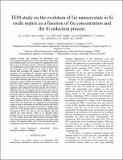TEM Study on the Evolution of Ge Nanocrystals in Si Oxide Matrix as a Function of Ge Concentration and the Si Reduction Process
Author(s)
Chew, Han Guan; Choi, Wee Kiong; Foo, Y.L.; Chim, Wai Kin; Fitzgerald, Eugene A.; Zheng, F.; Samanta, S.K.; Voon, Z.J.; Seow, K.C.; ... Show more Show less
DownloadAMMNS011.pdf (610.1Kb)
Metadata
Show full item recordAbstract
Growth and evolution of germanium (Ge) nanocrystals embedded into a silicon oxide (SiO₂) system have been studied based on the Ge content of co-sputtered Ge-SiO₂ films using transmission electron microscopy (TEM) and X-ray photoelectron spectroscopy. It was found that when the proportion of Ge relative to Ge oxide is 20%, TEM showed that annealing the samples at 800°C for 60 min resulted in the formation of a denuded region between the silicon/silicon oxide (Si/SiO₂) interface and a band of Ge nanocrystals towards the surface of the film. By introducing a 20nm thick thermal oxide barrier on top of the silicon (Si) substrate on which the film is deposited, no denuded region in the bulk of this sample is observed. It is proposed that this barrier is effective in reducing both Ge diffusion into the Si substrate and Si diffusion from the substrate into the film. Si diffusing from the Si substrate reduces the Ge oxide into Ge which can subsequently diffuse into the Si substrate. However, the oxide barrier is able to confine the Ge within the oxide matrix so that the denuded region in the bulk of the film cannot form. However the reduction in diffusion should be more significant for Ge as its diffusion coefficient is lower than Si due to its larger size. It is suggested that the denuded region consists of amorphous Ge diffusing towards the Si/SiO₂ interface. When the Ge content is increased to slightly more than 70%, TEM showed that Ge nanocrysyals formed after annealing at 800°C for only 30 min for samples with and without the oxide barrier. There is no denuded region between the Ge nanocrystals band and the Si/SiO₂ interface for both samples but it was observed that coarsening effects were more prominent in the film deposited on top of the oxide barrier. The reduction effect of Si on Ge oxide should not play a significant role in these samples as the Ge content is high.
Date issued
2006-01Series/Report no.
Advanced Materials for Micro- and Nano-Systems (AMMNS)
Keywords
Germanium nanocrystals, Silicon reduction, Germanium diffusion